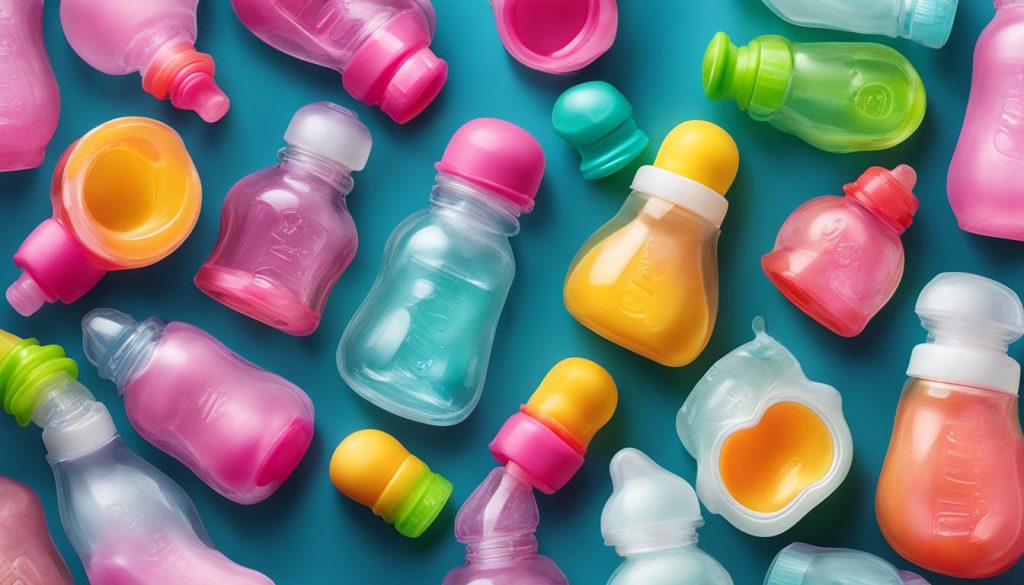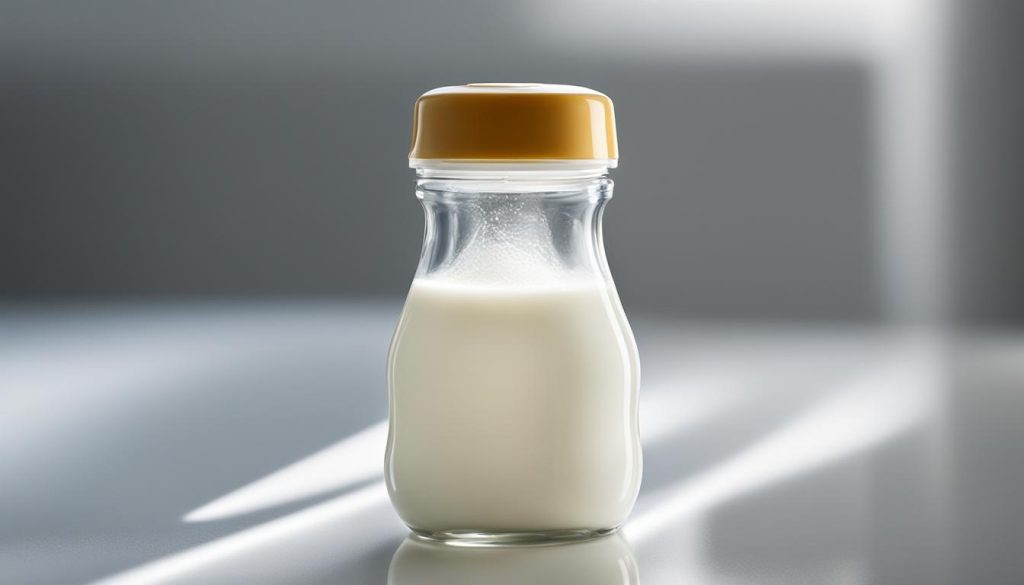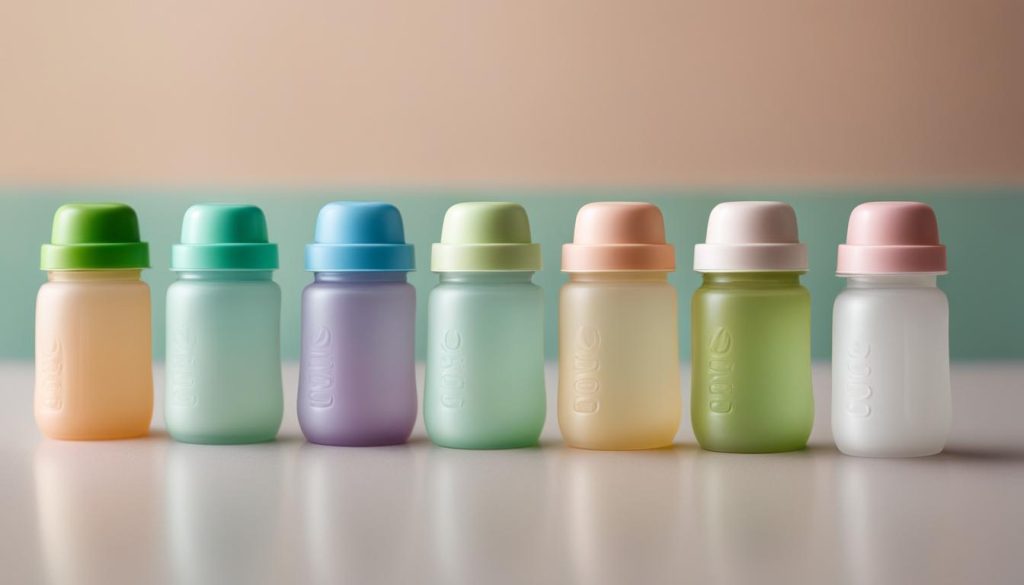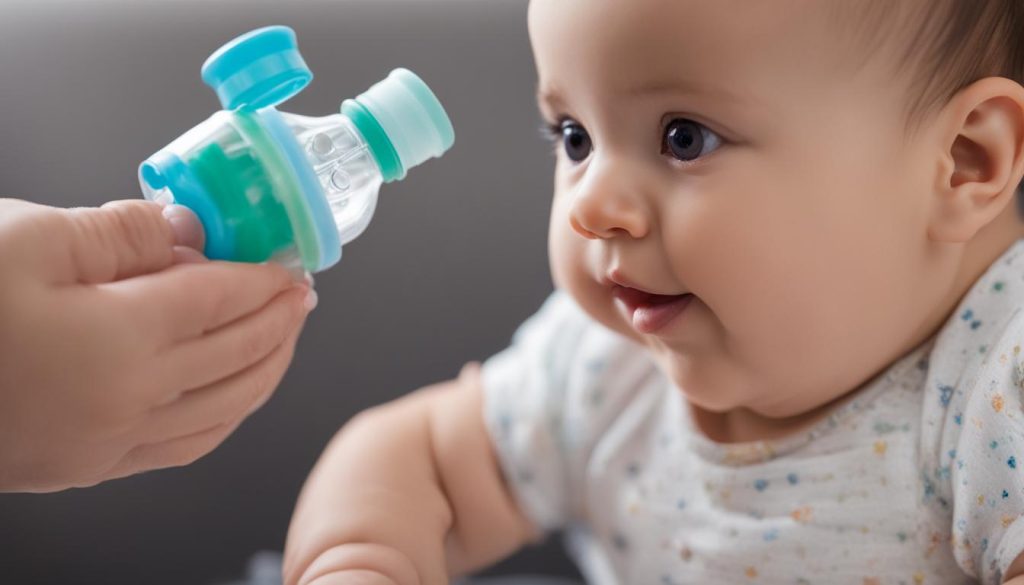Bottle-feeding an infant can be a process of trial and error, with a wide range of bottle options and nipple flows available. Choosing the right bottle and nipple is important for successful feeding. Bottle-feeding positions such as cradling the baby, sitting position, resting baby on your legs, and using a feeding pillow can provide comfort and interaction during feeding. Pacing the feeding and following the baby’s cues for hunger and fullness are essential. The best way to prepare bottles is to choose the right bottle for your baby’s needs and follow the guidelines for preparing formula or breast milk. It is important to warm the bottle properly and be aware of the expiration times for both breast milk and formula. Bottle-feeding frequency will vary as the baby grows, and parents should always follow the baby’s hunger cues.
When it comes to baby feeding, understanding the basics of bottles and nipples is crucial. In this article, I will explore the different factors to consider when choosing the right bottle and nipple for your little one. From bottle-feeding positions to bottle maintenance and sterilization, we will cover everything you need to know for successful bottle feeding. Whether you’re a new parent or looking to enhance your bottle-feeding techniques, this comprehensive guide will provide you with expert advice and tips to master the art of baby feeding.
Choosing the Right Bottle and Nipple
When it comes to bottle-feeding your baby, choosing the right bottle and nipple is essential for a successful feeding experience. There are a variety of bottle options available, each designed to meet different needs such as colicky babies, gassy babies, and breastfed babies. It may require some trial and error to find the perfect bottle for your little one.
Start with a slow-flow nipple and gradually switch to faster flow options as your baby grows. It’s important to consider the ease of cleaning and reassembling the bottle, as well as the similarity of the bottle’s shape and feel to a mother’s breast. Bottle and nipple compatibility is also crucial to ensure a secure and leak-free fit.
When choosing a bottle, look for features that make it easy to clean and maintain. A bottle that is dishwasher safe or has wide openings for easy hand washing can save you time and effort. Additionally, some bottles are designed to reduce the amount of air your baby ingests while feeding, which can help prevent gas and discomfort.
Remember that every baby is different, so what works for one may not work for another. Don’t hesitate to try different brands and options until you find the perfect bottle and nipple combination that meets your baby’s unique needs. Ultimately, the right bottle and nipple will help make feeding time a comfortable and enjoyable experience for both you and your little one.
| Factors to Consider | Benefits |
|---|---|
| Nipple Flow | Allows for gradual adjustment as the baby grows |
| Ease of Cleaning | Saves time and effort |
| Bottle Shape and Feel | Provides a familiar breastfeeding experience |
| Bottle and Nipple Compatibility | Ensures a secure and leak-free fit |
Bottle Maintenance and Sterilization
Ensuring proper bottle maintenance and sterilization is crucial for the health and safety of your baby. Thoroughly cleaning and sterilizing bottles and nipples is essential to prevent the growth of harmful bacteria and protect your little one from potential infections.
To clean the bottles, start by disassembling them and rinsing off any leftover milk or formula with warm soapy water. Use a bottle brush to scrub the inside and outside of the bottles, paying extra attention to the nipple and the bottom of the bottle where residue can accumulate. Rinse the bottles thoroughly to remove any soap residue.
Once the bottles are clean, it’s time to sterilize them. There are several methods you can use, depending on your preference and convenience. Boiling the bottles in a pot of water for at least 5 minutes is one effective method. Another option is to use a microwave sterilizer, which uses steam to kill bacteria. Alternatively, you can use sterilizing solutions or tablets specifically designed for bottle sterilization.
It’s important to note that sterilization should be done before the first use of the bottles and periodically thereafter. This is especially crucial if your baby is prone to infections or has a weakened immune system. Regular sterilization helps ensure that your baby’s feeding equipment remains hygienic and safe.
Table: Bottle Cleaning and Sterilization Methods
| Method | Description |
|---|---|
| Boiling | Place bottles in a pot of boiling water and let them boil for at least 5 minutes. Be sure to use enough water to cover the bottles completely. |
| Microwave Sterilizer | Use a microwave sterilizer, following the manufacturer’s instructions. This method utilizes steam to kill bacteria and sterilize the bottles. |
| Sterilizing Solutions or Tablets | Follow the instructions provided with the sterilizing solution or tablets. Generally, you’ll need to soak the bottles in the solution or dissolve the tablet in water and submerge the bottles for a specific period of time. |
Proper bottle maintenance and sterilization are important to ensure a safe and hygienic feeding environment for your baby. By following the recommended cleaning and sterilization methods, you can provide the best possible care for your little one and promote their overall well-being.
Bottle and Nipple Materials: Exploring the Options
When it comes to choosing the right bottle and nipple for your baby, it’s important to consider the materials they are made from. Different materials offer unique advantages and considerations that can impact your baby’s feeding experience. Let’s take a closer look at the common materials used for baby bottles and nipples:
Glass Bottles
Glass bottles are known for their durability and resistance to scratches. They are a popular choice for parents who prioritize safety and want to avoid potential chemical leaching from plastic bottles. Glass bottles are also great for parents who prefer a more eco-friendly option. However, it’s important to note that glass bottles are heavier compared to other materials and can break if dropped, so extra care is required.
Plastic Bottles
Plastic bottles are lightweight, affordable, and shatterproof, making them a convenient choice for many parents. However, it’s essential to choose plastic bottles that are free from harmful chemicals like BPA (Bisphenol A) and phthalates. Look for bottles labeled as BPA-free and made from food-grade polypropylene or polyethylene. Additionally, plastic bottles should be checked regularly for signs of wear and tear, such as cracks or discoloration, and should be replaced if necessary.
Silicone Bottles
Silicone bottles offer a unique set of advantages for both babies and parents. They are soft, squeezable, and easy to clean. Silicone is a hypoallergenic material that is resistant to bacteria growth, making it a hygienic choice for bottle feeding. These bottles are also microwave and dishwasher safe, adding to their convenience. However, it’s important to note that silicone bottles are generally more expensive compared to glass or plastic options.
Latex and Silicone Nipples
Nipples are available in two main materials: latex and silicone. Latex nipples are soft and flexible, closely resembling the texture of a mother’s breast. However, latex nipples can wear out more quickly and may cause allergic reactions in some babies. Silicone nipples, on the other hand, are durable and can withstand repeated sterilization. They are also less likely to cause allergies, making them a popular choice among parents. It’s important to regularly inspect nipples for signs of damage or wear and replace them as needed.
When choosing the right bottle and nipple material, consider your baby’s comfort, your preferences, and any specific needs or concerns. It’s always a good idea to consult with your pediatrician or lactation consultant for personalized advice and recommendations.
| Material | Advantages | Considerations |
|---|---|---|
| Glass | Durable, resistant to scratches, safe from chemical leaching | Heavier, can break if dropped |
| Plastic | Lightweight, affordable, shatterproof | Possible chemical leaching, regular inspection for wear and tear |
| Silicone | Soft, squeezable, easy to clean, hypoallergenic | More expensive |
| Latex and Silicone Nipples | Latex: Soft and flexible. Silicone: Durable, easy to clean, less likely to cause allergies | Latex: Wear out more quickly, potential allergic reactions. Silicone: Less texture similar to a mother’s breast |
Tips for Bottle-Feeding a Breastfed Baby
Bottle-feeding a breastfed baby can be a challenging process, but with the right approach and some patience, it can be done successfully. Here are some tips to help you navigate this transition:
- Wait until breastfeeding is well established: It’s best to wait until your baby is around 2 to 4 weeks old and breastfeeding is well established before introducing a bottle. This will help ensure that your baby is comfortable with breastfeeding before introducing something new.
- Use expressed breast milk: Start by offering your baby expressed breast milk in a bottle. This will help make the transition easier as the milk will be familiar to your baby.
- Be patient: It may take some time for your baby to adjust to bottle-feeding. Be patient and give your baby time to get used to the bottle. Offer the bottle in a calm and relaxed environment to help reduce any stress or anxiety.
- Enlist the help of someone else: Sometimes babies may resist taking a bottle from their breastfeeding mother. Enlist the help of a partner, family member, or friend to offer the bottle. Your baby may be more willing to accept the bottle from someone other than the breastfeeding mother.
- Follow proper bottle-feeding positions: Use the same positions and techniques that you would use when breastfeeding to help your baby feel more comfortable. Experiment with different positions to find what works best for you and your baby.
- Allow breaks during feeding: Just like with breastfeeding, it’s important to follow your baby’s cues during bottle-feeding. Allow breaks for burping and give your baby time to rest if needed.
Remember, every baby is different, and it may take some time to find what works best for your little one. Stay patient, be flexible, and trust your instincts as a parent. With time and practice, you and your baby will find a bottle-feeding routine that works for both of you.
| Pros of Bottle-Feeding a Breastfed Baby | Cons of Bottle-Feeding a Breastfed Baby |
|---|---|
|
|
It’s important to note that every mother and baby’s breastfeeding journey is unique. If you have any concerns or need additional support, reach out to a lactation consultant or your healthcare provider. They can provide personalized guidance and advice to ensure a smooth transition from breast to bottle.
Transitioning from Breast to Bottle
Transitioning from breastfeeding to bottle feeding can be a gradual process that requires patience and understanding. It’s important to approach this transition with care, considering both the baby’s needs and the mother’s breastfeeding journey.
When starting the transition, it’s recommended to substitute one breastfeeding session per day with a bottle feeding. This allows the baby to become familiar with the bottle while still maintaining some breastfeeding sessions for comfort and bonding. It’s important to follow the baby’s lead and gradually replace more breastfeeding sessions with bottle feedings over time.
During this transition, it’s essential to maintain breast milk supply by pumping regularly and emptying the breasts completely. This helps ensure that the mother’s milk production remains consistent during the switch from breastfeeding to bottle feeding. Consulting with a lactation consultant or pediatrician can provide valuable guidance and support throughout this process.
The journey from breast to bottle can be an emotional and challenging one for both the baby and the mother. It’s important to approach the transition with flexibility and understanding, allowing both parties to adapt at their own pace. With patience and support, this gradual transition can be a successful and positive experience for everyone involved.
Expert Advice for Successful Bottle Feeding
When it comes to bottle feeding your baby, there are a few expert tips that can help ensure a successful and comfortable feeding experience.
First and foremost, it’s important to pay attention to your baby’s feeding cues. Look for signs of hunger, such as rooting or sucking on their fist, and try to feed them before they become overly fussy or upset. Similarly, watch for signs that your baby is full, such as turning their head away or pushing the bottle away. Allowing your baby to regulate their own hunger can prevent overfeeding and promote healthy eating habits.
Proper positioning and technique are also key to successful bottle feeding. Hold your baby in a semi-upright position and make sure the milk is covering the nipple to minimize the risk of choking and swallowing air. This can be particularly important if you are using a bottle with a fast flow nipple. Take your time during feedings, allowing your baby to pause and take breaks as needed. This can help prevent them from becoming overwhelmed and ensure a more comfortable feeding experience.
If you have any concerns or questions about bottle feeding, don’t hesitate to seek advice from a lactation consultant or pediatrician. They can provide personalized guidance and support to help you navigate any challenges you may encounter. Remember, every baby is different, and what works for one may not work for another. With patience, practice, and the right support, you can master the art of bottle feeding and provide your baby with the nourishment they need.
FAQ
What should I consider when choosing a bottle and nipple?
Factors to consider include ease of cleaning, similarity to a mother’s breast, and bottle and nipple compatibility.
How should I clean and sterilize baby bottles and nipples?
Bottles should be cleaned with warm soapy water and thoroughly rinsed before sterilization. Sterilization methods include boiling, using a microwave sterilizer, or using a sterilizing solution.
What materials are baby bottles and nipples made from?
Baby bottles can be made from glass, plastic, or silicone. Nipples can be made from latex or silicone.
How can I introduce a bottle to a breastfed baby?
Wait until breastfeeding is well established before introducing a bottle. Start with expressed breast milk and be patient. Enlist the help of someone other than the breastfeeding mother.
How can I transition from breastfeeding to bottle feeding?
Transition gradually by substituting one breastfeeding session per day with a bottle and gradually replacing more sessions over time. Maintain breast milk supply by pumping regularly.
What should I pay attention to during bottle feeding?
Pay attention to the baby’s feeding cues, pace the feeding, and use proper bottle-feeding positions to reduce the risk of choking and swallowing air.
What additional guidance can I seek for successful bottle feeding?
Seek advice from a lactation consultant or pediatrician for additional guidance and support.




